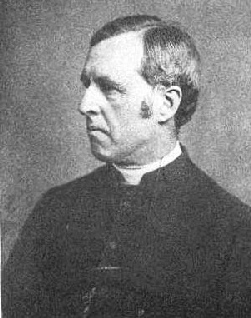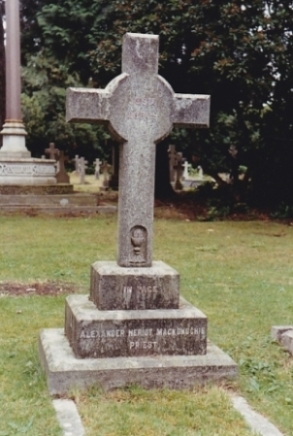

© John Clarke 2014-
John Clarke
Historian of Brookwood Cemetery

Alexander Heriot Mackonochie
 ALEXANDER HERIOT MACKONOCHIE (1825-
ALEXANDER HERIOT MACKONOCHIE (1825-
The Rev. Alexander Heriot Mackonochie long held the foremost position among the most advanced clergy of the Ritualist party, and attracted to himself the warmest love and devotion of that section of the Church. Rev. Mackonochie was educated at Wadham College, Oxford, where he took his degree in 1848. His name appeared in the second class of classical honours, while those of Mr. E. St. John Parry and a future Bishop of Chester were in the first class. In 1849 he was ordained deacon, and in the following year priest, by the Bishop of Salisbury.
Three years were then spent between the curacies of Westbury, in Wiltshire, and Wantage, in Berkshire. Then, in 1857, he was transferred to London. His lot was cast in the parish of St. George’s-
Bryan King was in 1863 appointed to the vicarage of Avebury, in the diocese of Salisbury. Rev. Mackonochie, in 1862, was chosen as the first incumbent of the new church of St. Alban the Martyr, which had just been built at the expense of Mr. John Hubbard, now Lord Addington. Here at least Rev. Mackonochie had no mob to deal with. The parish was almost as poor as that which he had just left, but the parishioners were for the most part of a different character. His clergy house soon came to be regarded as the place where all could find relief and comfort in their troubles, physical and spiritual. This living Rev. Mackonochie held for 20 years, during which he gave his taste for high ritual the fullest scope. So far did he go that Mr. Hubbard, the Founder of the church, publicly protested against the proceedings of the incumbent. Protests, however,from whatever source they came, had little effect on Rev. Mackonochie.
But the “aggrieved parishioner” was set in motion, and for some years the Courts were full of the case of “Martin v. Mackonochie”. It was understood that the proceedings were taken by the Church Association. Rev. Mackonochie systematically set the decrees of the Courts at naught; and the trouble was only brought to an end by an exchange of livings between Rev. Mackonochie and the Rev. R. A. J. Suckling, vicar of St. Peter’s, London Docks. This exchange was made with the approval of the Archbishop of Canterbury, Dr. Tait, and the Bishop of London, Dr. Jackson, both of whom, though by no means willing to sanction what they thought his extreme ritual, had learned to respect him as a high-
His health had long been failing, and a telegram was received on Saturday night at the St Alban’s Clergy-
“He went Thursday morning to walk to head of loch, ten miles off, with two dogs, deerhound and terrier. Snowstorm came on and darkness, lost trail, wandering miles up into mountains, lay down, dogs watched two days and nights; would not let searchers approach. Found 17 miles from home, head frozen into snow. Hat off. Lies in Bishop’s chapel; no trace of suffering upon face. I start early to-
A local journalist gave further particulars:—
“On Wednesday last Rev. Mackonochie walked up Loch Leven side and evidently enjoyed it, for on Thursday morning he said he intended to take a much longer walk. He left at 8 o’clock, having a deerhound and a terrier with him. He passed Kinlochmore lodge about noon and was seen by one of the keepers going in the direction of the bridge. As he did not return to Aultshellach house in the evening some alarm was felt, and a party was sent as far as Kinloch to make inquiries, but nothing was known beyond that he had been seen passing at noon. The night was very stormy. On Friday a large party from North Ballachulish, accompanied by the Bishop of Argyll, went up and, accompanied by all the shepherds and keepers, searched the hills in all directions, continuing the search all night an d up to 2 p.m. on Saturday, when they were about to give up the search in that part of the forest. But as Hugh M’Coll and Duncan M’Coll, jun., of Kinloch, were crossing a wire fence they noticed the deerhound sitting beside a snow wreath in a hollow close to the fence, and on going over they found the body lying in the hollow and the two dogs beside it. The Bishop and the rest of the party were hailed and arrangements were made for carrying the body home from the glen. It appears that Rev. Mackonochie, after passing Kinloch, had gone along the road six miles, and when darkness set in he must have lost the road, for he had gone about a mile and a half off the path up the hillside, and, having come to a wire fence, he evidently had followed it until he came to the hollow, which was surrounded by a heavy wreath of snow, over which he could not go. The hollow was very much trampled, apparently by Rev. Mackonochie walking round and round, until, becoming exhausted, he lay down with his hand under his head. When found, the head and shoulders were covered with snow. The body was taken to Aultshellach house that evening and will be removed to England.”
d up to 2 p.m. on Saturday, when they were about to give up the search in that part of the forest. But as Hugh M’Coll and Duncan M’Coll, jun., of Kinloch, were crossing a wire fence they noticed the deerhound sitting beside a snow wreath in a hollow close to the fence, and on going over they found the body lying in the hollow and the two dogs beside it. The Bishop and the rest of the party were hailed and arrangements were made for carrying the body home from the glen. It appears that Rev. Mackonochie, after passing Kinloch, had gone along the road six miles, and when darkness set in he must have lost the road, for he had gone about a mile and a half off the path up the hillside, and, having come to a wire fence, he evidently had followed it until he came to the hollow, which was surrounded by a heavy wreath of snow, over which he could not go. The hollow was very much trampled, apparently by Rev. Mackonochie walking round and round, until, becoming exhausted, he lay down with his hand under his head. When found, the head and shoulders were covered with snow. The body was taken to Aultshellach house that evening and will be removed to England.”
The funeral service was held in the church which is identified with his name, St. Alban the Martyr, Holborn, and the interment took place in St. Alban’s ground at Brookwood.
Further reading
Archbold, William Arthur Jobson. Alexander Heriot Mackonochie. In Lee, Sidney (ed.). Dictionary of National Biography. London: Smith, Elder & Co, 1893, pp. 185-
Reynolds, Michael. Martyr of Ritualism: Father Mackonochie of St. Alban's, Holborn. London: Faber and Faber, 1965.
Towle, E.A.; Russell, E.F. (Ed.). Alexander Mackonochie: A Memoir. London: Kegan Paul, 1890.
Copyright © 2019 by John M. Clarke All Rights Reserved